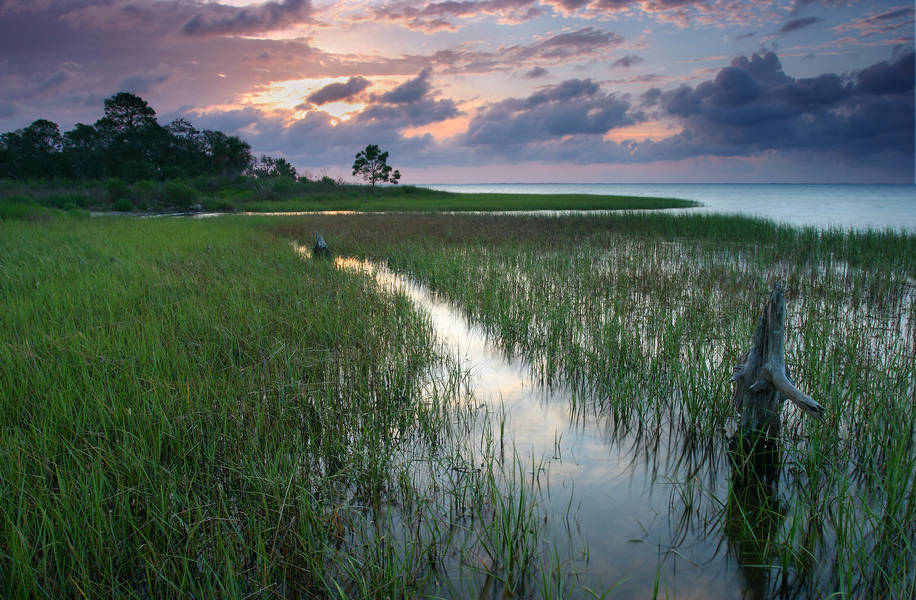What is Dredge and Fill?
Dredging means excavation in wetlands or other surface waters or excavation in uplands that creates wetlands or other surface waters. Filling means deposition of any material (such as sand, dock pilings or seawalls) in wetlands or other surface waters.
The surface waters regulated under the dredge and fill program include bays, bayous, sounds, estuaries, lagoons, rivers, streams, the Gulf of America, the Atlantic Ocean, most natural lakes, and all waters and wetlands (natural or artificial).
Why are dredge and fill activities regulated?
Dredging and filling in the surface waters of Florida has been regulated since the early 1970s. This program was established under Chapter 403, F.S., to protect our surface waters from degradation caused by the loss of wetlands and from pollution caused by construction activities.
Alteration of wetlands and other surface waters may have a detrimental impact on the environment. That impact could extend beyond the limits of the work site, affecting other public or private property. Polluted waters can be conveyed off-site through connecting waterbodies. The elimination or degradation of wetlands will cause a reduction of beneficial functions provided by the wetlands.
Wetlands provide a number of important and beneficial functions. During periods of heavy rainfall, wetlands serve as flood storage areas, where water can spread out without damage to developed uplands. As the water passes through the wetlands, pollutants are filtered out. Wetlands also stabilize shorelines, thereby preventing the harmful effects of erosion. Wetlands produce the basic food material used by many fish and other aquatic life. Some wetlands also serve as nursery grounds for fish and rookery areas for birds. Many wildlife species, some of which are threatened or endangered, need to live in wetlands for all or part of their life.
Filling wetlands can increase on-site and off-site flooding. Dredging and filling also can degrade the quality of water during and after construction, and can reduce the populations of fish and wildlife. In fact, it has been estimated that as much as 80 percent of our recreationally and commercially important fish species are dependent upon wetlands for at least some portion of their life cycle.
How is dredging and filling regulated?
Any activity on or over wetlands and other surface waters (dredging and filling) is regulated by the department and five water management districts (Northwest Florida, Suwannee River, St. Johns River, Southwest Florida and South Florida) through the Environmental Resources Permitting program. Dredging and filling also is regulated by the federal government under a separate program administered by the U.S. Army Corps of Engineers. The process is initiated by submitting a joint (interagency) application to the department or to one of the above water management districts. The appropriate agency is determined by a division of responsibilities specified in Operating Agreements between the agencies. Upon receipt of the application by the department or district, a copy also is forwarded to the Corps to initiate the federal permitting process.
Streamlining
The state phased out the dredge and fill permit program by combining it with the management and storage of surface water (MSSW) permit program of the districts, creating a new environmental resource permit (ERP) program under Part IV of Chapter 373 of the Florida Statutes. The dredge and fill program described above will remain in place only within the limits of the Northwest Florida Water Management District (NWFWMD) for permitted activities or applications deemed complete before November 1, 2010, and for certain grandfathered activities in the rest of the state. The ERP program is in effect throughout the state. The ERP program regulates dredging and filling in all wetlands and other surface waters, and also regulates the aspects of the MSSW program such as water quantity (flooding) and water quality (stormwater) in both wetlands and uplands.
In addition to the regulatory (permit) program discussed above, permission to use any sovereign (state-owned) submerged lands also must be addressed in the review process. For activities located on sovereign submerged lands, the application to use these areas (known as the proprietary authorization) will be reviewed in conjunction with the regulatory application. Both forms of authorization will be requested in the same application, and will be reviewed and granted or denied at the same time. This linkage will streamline the review of the state regulatory and proprietary authorizations statewide for both the department and the WMDs, except within the NWFWMD.
To further streamline the above programs, the department and the WMDs are developing rules to allow us to delegate the ERP program to qualified local governments. All regulatory authorizations under the ERP program, as well as any additional local permits, will be granted or denied at the same time by the local government once they are granted delegation. The department and WMDs are also working with the Corps to reduce overlap in state and federal regulatory permits. Until the local and federal programs are fully linked with the WR and ERP programs described above, applicants are advised to work with, and obtain all needed authorizations from, all of these agencies prior to dredging and filling in wetlands or other surface waters.


